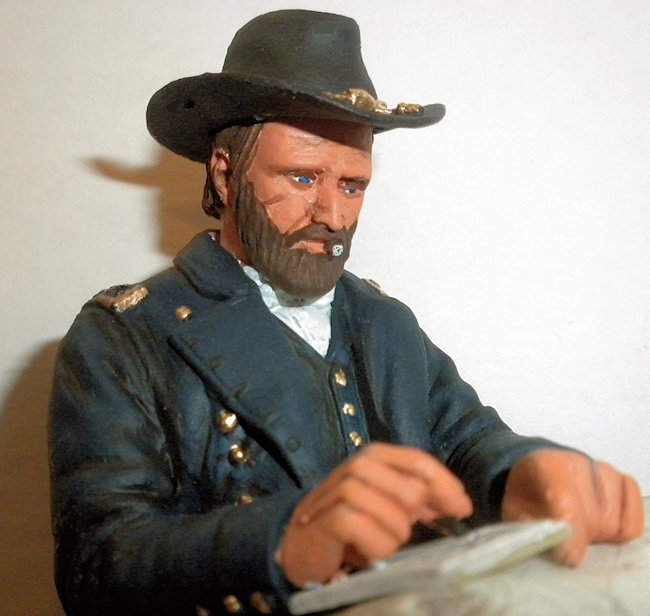
Verlinden 120mm Ulysses S. Grant
| KIT #: | 1853 |
| PRICE: | $27.00 SRP |
| DECALS: | N/A |
| REVIEWER: | Blair Stewart |
| NOTES: | Resin figure |

| HISTORY |
Warfare has a habit of bringing forth leaders that one would not think would fit the mold of “greatness:” one can suppose this is true because there is no real way to simulate the difficult and unpredictable conditions of warfare that inevitably occur in the heat of battle. The United States maintains service academies whose primary purpose is to create such leaders, but often these great leaderscome from sources other than the academies. The fact is, it is hard to predict who will “step up to the military leadership plate” when everything is on the line and demonstrate great leadership that will be significant in the history of warfare.
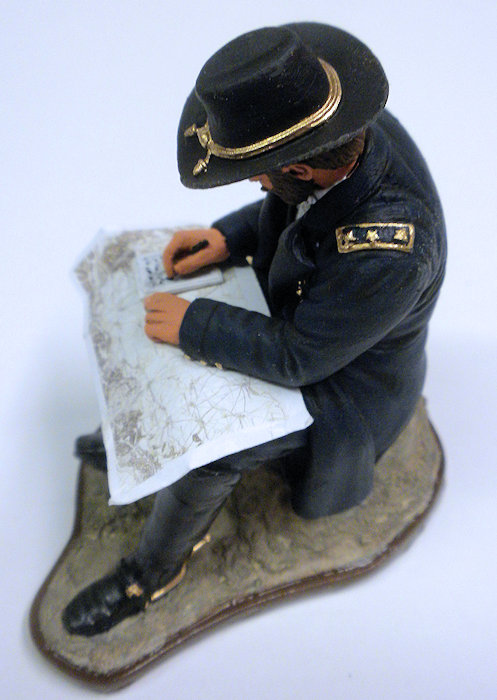 Ulysses
S. Grant was clearly such a leader. Grant graduated in 1843 from the U.S.
Military Academy at West Point: twenty-first out of a final class of
thirty-nine, and this low rank denied him the opportunity for an appointment to
the prestigious cavalry corps. He ended up in the infantry, but he planned to
resign as soon as his mandatory service time ended and pursue a career as a math
teacher. He was initially assigned to Jefferson Barracks near St. Louis,
Missouri, where he eventually met his wife Julia, who was the sister of his West
Point classmate Frederick Dent.
Ulysses
S. Grant was clearly such a leader. Grant graduated in 1843 from the U.S.
Military Academy at West Point: twenty-first out of a final class of
thirty-nine, and this low rank denied him the opportunity for an appointment to
the prestigious cavalry corps. He ended up in the infantry, but he planned to
resign as soon as his mandatory service time ended and pursue a career as a math
teacher. He was initially assigned to Jefferson Barracks near St. Louis,
Missouri, where he eventually met his wife Julia, who was the sister of his West
Point classmate Frederick Dent.
In the midst of rising tensions with Mexico, Grant's unit shifted to Louisiana as part of the Army of Observation under Major General Zachary Taylor. When the Mexican–American War broke out in 1846, the US Army entered Mexico. Although a quartermaster, Grant led a cavalry charge at the Battle of Resaca de la Palma. At Monterrey he demonstrated his equestrian ability by volunteering to carry a dispatch through sniper-lined streets while hanging off the side of his horse, keeping the animal between him and the enemy. The US Army later divided its Mexican forces, sending some troops (including Grant's unit) to form a new army under Major General Winfield Scott. Scott's army eventually landed at Veracruz and advanced toward Mexico City. They met the Mexican forces at the battles of Molino del Rey and Chapultepec outside Mexico City. Grant was a quartermaster in charge of supplies and did not have a combat role, but he yearned for one and finally was allowed to take part in dangerous missions. At Chapultepec, men under Grant's command dragged a disassembled howitzer into a church steeple, reassembled it, and shelled nearby Mexican troops. His bravery and initiative earned him brevet promotions; he became a temporary captain while his permanent rank was lieutenant. Scott's army later entered the city, and the Mexicans agreed to peace shortly afterward.
During the Mexican War Grant studied the tactics and strategies of Scott and others, often second-guessing their moves beforehand. In his Memoirs, he wrote that this is how he learned about military leadership, and in retrospect identified his leadership style with Taylor's. Even so, he believed that the Mexican war was wrong and that the territorial gains from the war were designed to expand slavery.
Grant's mandatory service expired during the war, but he chose to stay in the service. He married Julia on August 22, 1848, four years after they became engaged. Grant's first post-war assignments took him and Julia to Detroit and then to Sackets Harbor, New York. In 1852, Grant's was assigned to Fort Vancouver in the Oregon Territory. Julia, who was eight months pregnant with Ulysses Jr., did not accompany him to this post. In 1854, he decided to retire from the service, but he struggled financially in civilian life. When the Civil War began in 1861, he rejoined the U.S. Army.
Without any formal rank in the army, Grant helped recruit a company of volunteers and accompanied the regiment to Springfield, Illinois’ state capital. During this time, Grant saw that the war would be fought primarily by volunteers and not by career soldiers. Governor Richard Yates offered Grant a position recruiting and training volunteer units, which he accepted, but he still wanted a field command in the regular army. He made several efforts through contacts (including Major General George B. McClellan) to acquire such a position. McClellan refused to meet him, remembering Grant's earlier reputation for drinking while stationed in California. Meanwhile, he continued serving at the training camps and made a positive impression on the volunteer Union recruits.
With the aid of his advocate in Washington,
Illinois congressman Elihu B. Washburne, Grant was formally promoted to Colonel
on June 14, 1861, and put in charge of disciplining the unruly 21st Illinois
Volunteer Infantry Regiment. Transferred to northern Missouri, Grant was
promoted by President Lincoln to Brigadier General, backdated to May 17, 1861,
again with Washburne's support. Believing Grant was a general of "dogged
persistence" and "iron will", Major General John C. Frémont assigned Grant
command of troops near Cairo, Illinois toward end of August 1861. Under
Frémont's authority Grant advanced into Paducah, Kentuc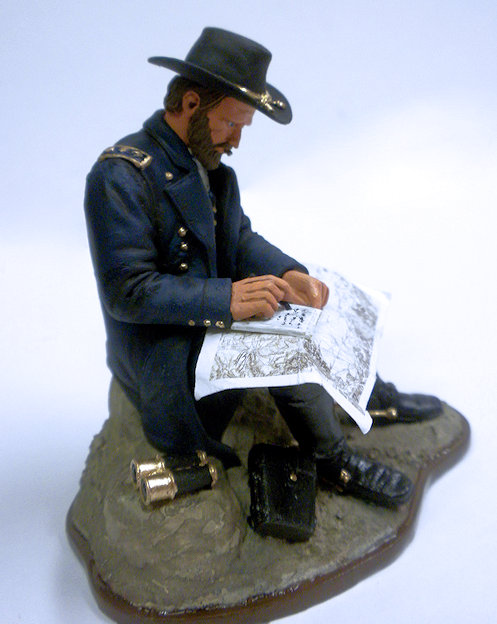 ky
and took the town without a fight.
ky
and took the town without a fight.
On November 7, 1861 Grant and his troops crossed the Mississippi to attack Confederate soldiers encamped in Belmont, Missouri. They took the camp, but the reinforced Confederates under Brigadier General Gideon J. Pillow forced a retreat to Cairo. A tactical defeat, the battle nonetheless gave Grant and his volunteers confidence and experience. After Belmont, Grant asked his new commander Henry Halleck (Lincoln had relieved Frémont of command) for permission to move against Fort Henry in Tennessee, which would open the Tennessee River to the passage of Union gunboats. Halleck agreed, and Grant's troops, in close cooperation with US naval forces captured Fort Henry on February 6, 1862.
Emboldened by Lincoln's call for a general advance of all Union forces, Grant ordered an immediate assault on nearby Fort Donelson, which dominated the Cumberland River (this time without Halleck's permission). After several days of difficult fighting, the Confederate commander Brigadier General Simon Bolivar Buckner acceded to Grant's demand for his "unconditional and immediate surrender." Lincoln promoted Grant to major general of volunteers while the Northern press treated Grant as a hero. Playing off his initials, they began calling him "Unconditional Surrender Grant".
In April 1862, Grant led Union forces in the Battle of Shiloh, where he earned a reputation as an aggressive commander. Encamped on the western bank of the Tennessee River, Grant's Army of the Tennessee, now numbering about 45,000 troops, prepared to attack a Confederate army of roughly equal strength at Corinth, Mississippi, a vital railroad junction. The Confederates, led by Generals Albert Sidney Johnston and P.G.T. Beauregard, struck first on April 6, 1862, attacking five divisions of Grant's army bivouacked at Pittsburg Landing, not far from the Shiloh meetinghouse. Grant's troops were not entrenched and were taken by surprise, falling back before the Confederate assault. At day's end, the Confederates captured one Union division, but Grant's army was able to hold the Landing.[ The remaining Union army might have been destroyed, but the Confederates halted due to exhaustion, confusion, and a lack of reinforcements. Grant, bolstered by 18,000 fresh troops, counterattacked at dawn the next day [The Union Army regained the field and forced the rebels to retreat back to Corinth.
After Shiloh, the Northern press criticized Grant for high casualties and for his alleged drunkenness during the battle. Shiloh was the costliest battle in American history to that point, with total casualties of about 23,800. Halleck arrived at Pittsburg Landing on April 9, and removed Grant from field command, proceeding to capture Corinth. Discouraged and disappointed, Grant considered resigning his commission, but Brigadier General William Tecumseh Sherman, one of his division commanders, convinced him to stay. Lincoln overruled Grant's critics, saying "I can't spare this man: he fights." Ordered to Washington, Halleck reinstated Grant as field commander of the Army of the Tennessee.
On September 19, 1862, Grant's army defeated Confederates at the Battle of Iuka, Mississippi and then they successfully defended Corinth, inflicting heavy casualties on the Confederate forces. On October 25, Grant assumed command of the District of the Tennessee.
In July 1863, after a series of coordinated battles, Grant defeated Confederate armies and seized Vicksburg, finally giving the Union control of the Mississippi River and dividing the Confederacy in two.
On March 3, 1864, President Lincoln promoted Grant to Lieutenant General, giving him command of all Union Armies, under direct supervision only to the President. Grant assigned Sherman the Division of the Mississippi and traveled to Washington D.C., to meet with Lincoln and devise a strategy of total war against the Confederacy. After settling Julia into a house in Georgetown, Grant established his headquarters with General George Meade's Army of the Potomac in Culpeper, Virginia. He devised a strategy of coordinated Union offensives, attacking the rebel armies at the same time to keep the Confederates from shifting reinforcements within their interior lines.
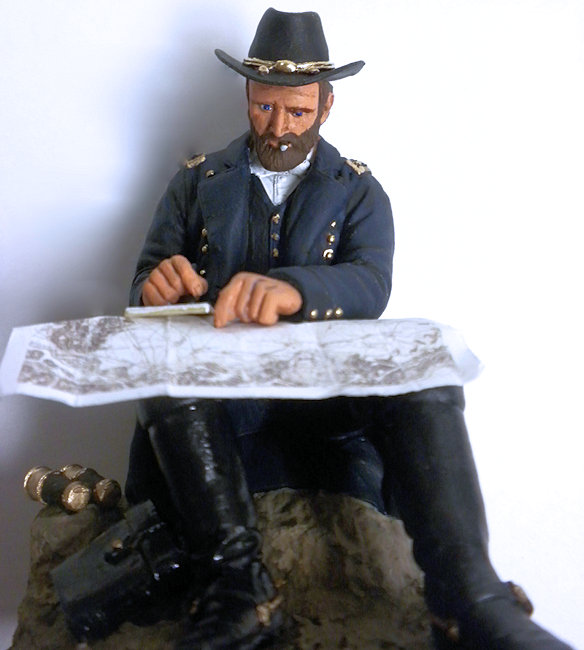 Sherman
was to pursue Joseph E. Johnston's Army of the Tennessee, while Meade would lead
the Army of the Potomac, with Grant in camp, to attack Robert E. Lee’s Army of
Northern Virginia. Major General Benjamin Butler was to advance towards Richmond
from the south, up the James River. If Lee were forced south as expected, Grant
would join forces with Butler's armies and be fed supplies from the James. Major
General Franz Sigel was to capture the railroad line at Lynchburg, move east,
and attack from the Blue Ridge Mountains. Grant knew that Lee had limited
manpower and that a war of attrition fought on a battlefield without
entrenchments would lead to Lee's defeat.
Sherman
was to pursue Joseph E. Johnston's Army of the Tennessee, while Meade would lead
the Army of the Potomac, with Grant in camp, to attack Robert E. Lee’s Army of
Northern Virginia. Major General Benjamin Butler was to advance towards Richmond
from the south, up the James River. If Lee were forced south as expected, Grant
would join forces with Butler's armies and be fed supplies from the James. Major
General Franz Sigel was to capture the railroad line at Lynchburg, move east,
and attack from the Blue Ridge Mountains. Grant knew that Lee had limited
manpower and that a war of attrition fought on a battlefield without
entrenchments would lead to Lee's defeat.
Sigel's and Butler's efforts bogged down, and Grant was left alone to fight Lee in a series of bloody battles known as the Overland Campaign. Grant crossed the Rapidan River on May 4, 1864, and attacked Lee in the Battle of the Wilderness, a hard-fought three-day battle with many casualties. Rather than retreat as his predecessors had done, Grant flanked Lee's army to the southeast and attempted to wedge his forces between Lee and Richmond at Spotsylvania Court House. Lee's army got to Spotsylvania first, and a costly battle 13-day battle ensued. During the battle, Grant attempted to break through Lee's line of defense, resulting in one of the bloodiest assaults of the Civil War, known as the Battle of the Bloody Angle.
Unable to break Lee's defenses, Grant again flanked the Confederate army to the southeast, meeting at North Anna. The Confederates had the defensive advantage, and Grant maneuvered his army to Cold Harbor, a vital railroad hub that linked to Richmond, Virginia, but Lee's men were again able to dig in against the Union assault. During the third day of the thirteen-day battle, Grant led a costly assault on Lee's trenches. As casualty reports became known in the North, heavy criticism fell on Grant, who was castigated as "the Butcher" by the Northern press after taking 52,788 casualties in the thirty days since crossing the Rapidan. Lee's army suffered 32,907 casualties, but he was less able to replace them. The costly Union assault at Cold Harbor was the second of two battles in the war that Grant later said he regretted (the other being his initial assault on the fortifications around Vicksburg). Without being detected by Lee, Grant pulled out of Cold Harbor and moved his army south of the James River, freed Butler’s surrounded army, and advanced toward Petersburg, Richmond's central railroad hub.
After crossing the James River undetected, Grant and the Army of the Potomac arrived at Petersburg. Confederate General P.G.T. Beauregard defended the city, and Lee's veteran reinforcements soon arrived. The result was a nine-month-long siege of Petersburg, stalling the advance. Northern resentment grew as the war dragged on, but an indirect benefit of the Petersburg siege was that Lee was forced to entrench and defend Richmond, and was unable to reinforce the Army of the Tennessee.
In April 1865, Grant had Lee’s army surrounded at Petersburg, but only on three sides. The Appomattox River prevented Grant’s forces from hemming in Lee’s northern flank. Moreover, the Confederates controlled all land north of the river and used it as a natural barrier against attack from their rear. After a series of devastating actions against his army, Lee decided to evacuate Petersburg and retreat as quickly as possible to the Carolinas. His two options were: abandon Richmond under cover of darkness and pull back, or punch through the Union lines and march south. In both of these options, Lee’s goal was to reach the Carolinas and waiting reinforcements.
The decisive Battle of Five Forks removed Lee’s option of
punching through the Union lines. In a lopsided victory, General Sheridan and
45,000 men cut the main road to North Carolina, and inflicted heavy casualties
on southern troops under General George Pickett. When the news of this great
victory reached Grant, he pushed his advantage by ordering an attack along
twelve miles of the Confederate lines. Some 100,000 m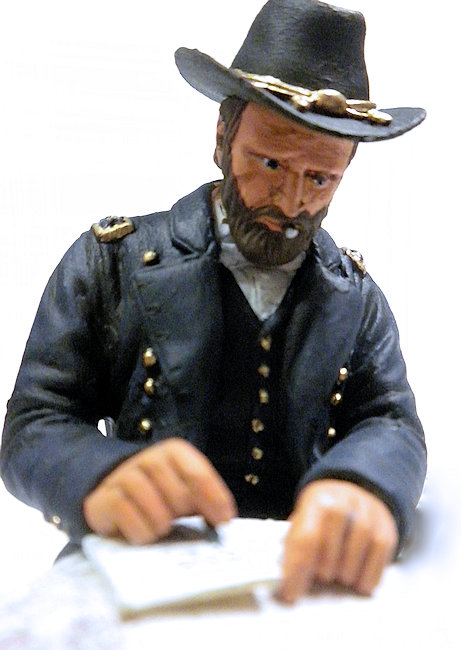 en
attack Lee’s entrenched army. After realizing the devastation to his forces, Lee
sent orders to his generals to fall back to the innermost defenses of Petersburg
and hold their positions. He then decided to evacuate Petersburg and retreat
back across the Petersburg bridges, and then race south toward the Carolinas. By
taking these steps, Lee hoped to regain the upper hand. Lee’s army escaped
across the Appomattox River, and this was start of Grant’s final chase to end
the war.
en
attack Lee’s entrenched army. After realizing the devastation to his forces, Lee
sent orders to his generals to fall back to the innermost defenses of Petersburg
and hold their positions. He then decided to evacuate Petersburg and retreat
back across the Petersburg bridges, and then race south toward the Carolinas. By
taking these steps, Lee hoped to regain the upper hand. Lee’s army escaped
across the Appomattox River, and this was start of Grant’s final chase to end
the war.
Lee's troops began deserting in large numbers; disease and lack of supplies also reduced the remaining Confederates. Lee attempted to link up with the remnants of Joseph E. Johnston's defeated army, but Union cavalry forces led by Sheridan were able to prevent this. Lee and his army finally surrendered to Grant at Appomattox Court House on April 9, 1865. Grant gave generous terms; Confederate troops surrendered their weapons and were allowed to return to their homes with their mounts, on the condition that they would not take up arms against the United States. On April 26, Johnson's Confederate army surrendered to Sherman under the same terms Grant offered to Lee. On May 26, Kirby Smith's western Confederate army surrendered and the Civil War was over.
After the Civil War, Grant led the army's supervision of Reconstruction in the former Confederate states. Elected president in 1868 and reelected in 1872, Grant stabilized the nation during the turbulent Reconstruction period, prosecuted the Ku Klux Klan, and enforced civil and voting rights laws using the army and the Department of Justice. He used the army to build the Republican Party in the South, based on black voters, Northern newcomers and native Southern white supporters. After the disenfranchisement of some former Confederates, Republicans gained majorities and African Americans were elected to Congress and high state offices. In his second term, the Republican coalitions in the South splintered and were defeated one by one as redeemers (conservative whites) regained control using coercion and violence. Grant's Indian peace policy initially reduced frontier violence, but is best known for the Great Sioux War of 1876, where George Custer and his regiment were wiped out at the Battle of the Little Bighorn. Throughout his presidency Grant was faced with charges of corruption in executive agencies, including congressional investigations of two cabinet secretaries.
| THE KIT |
The figure is another finely detailed 120mm cast resin military figure by Verlinden Productions. When completed, the figure strikes an interesting pose sitting on a rock and studying a campaign map.
As is typical of these figures, the kit comes in 17 separate cast resin parts with some of them attached to resin casting blocks. The arms, torso and legs are separate components, as are the figure’s individual pieces of equipment such as field glasses and field glasses or map case. Nice touches include the scale paper map and the cigar the figure is smoking as he studies the map. As usual, the sculpting of the figure is extremely sharp with the great detail afforded by the large 120mm scale.
Another plus is the base, which includes a cast rock and surrounding terrain on which the figure sits when finished.
| CONSTRUCTION |
As usual, my first step was to remove the various pieces from their casting blocks and then clean them up. For the larger pieces, I use a razor saw to cut the piece off the resin block, and then use a sharp Xacto knife to clean things up. One can also use a piece of sandpaper on a flat surface to remove the final casting block resin (exercise caution in doing so: it’s easy to get carried away with the sanding and sand away more than you want). Once I did this, I used Super Glue to assemble the torso, legs, arms and hands.
When it came to painting, I started by spray-painting the figure with Testors flat white enamel to serve as the base coat and provide a light base for subsequent hand painting.
T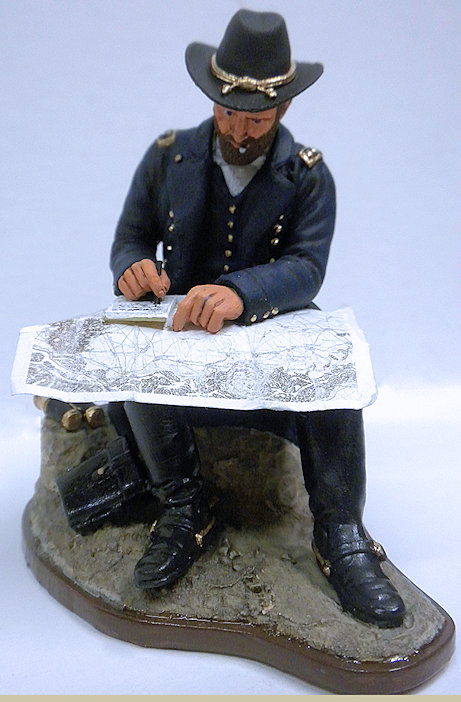 he
next step was to hand paint the figure. I began with the head and hands. For
these parts I used Testors flat flesh enamel. As always, with figures, a major
challenge is the skin tones, and then the proper shading to get some kind of
expression on the face. I used a darker shade of flesh tone (acrylic Apple
Barrel Lite Mocha) to facilitate later detailing of the face with lighter shades
of flesh tones. I then shaded various locations with darker shades of acrylic
colors to highlight the figure’s exposed flesh. I then painted the figure’s
hair, beard and moustache with acrylic burnt umber.
he
next step was to hand paint the figure. I began with the head and hands. For
these parts I used Testors flat flesh enamel. As always, with figures, a major
challenge is the skin tones, and then the proper shading to get some kind of
expression on the face. I used a darker shade of flesh tone (acrylic Apple
Barrel Lite Mocha) to facilitate later detailing of the face with lighter shades
of flesh tones. I then shaded various locations with darker shades of acrylic
colors to highlight the figure’s exposed flesh. I then painted the figure’s
hair, beard and moustache with acrylic burnt umber.
One of the most difficult things to do on a figure is to paint the eyes. For figures that are in an action pose, one can generally get by with a “squinting” look that does not require a painted eyeball. But this figure was an exception, as Grant is contemplating a map and making some notes. So I used Testors flat white to paint in oblong eyeballs, then some acrylic True Blue to represent the irises. Finally, I put black acrylic in the center of each iris to represent the pupils. The key to eyes is to then paint a bottom and top lid over the white eyeball so that the figure doesn’t have that “bug-eyed” look. I am not sure I achieved this on this figure, but I was able to at least reduce the amount of “bug-eyedness” (is that even a word? Probably not...).
For most of the other parts of the figure, I primarily used relatively inexpensive flat acrylic paints available from stores such as Walmart, Michaels, and Hobby Lobby. Another challenge for this particular figure was the blue uniform color. After finding some pictures on the Internet of “real” Union Army officer uniforms, I began mixing blue paints with black until I got a color that was close enough. The Union uniforms were almost blue-black, but on a small figure I decided this needs to be lightened up a little bit; otherwise, it will just appear to be black. I then highlighted various folds in the uniform with flat black paint.
For the riding boots and field glasses case, I used black acrylic and then brushed on some Future Floor Polish to give these the appearance of semi-shiny leather.
For the buttons, field glasses metal parts, uniform insignia, and hat braid, I used Testors gold enamel.
Finally, I painted the base with acrylic tan, and then used a black wash to bring out the definition of the soil, sand and rocks. I painted the bottom of the base with acrylic burnt umber, and then coated that portion of the base with Future Floor Polish to simulate lacquered wood.
| CONCLUSIONS |
This is another outstanding Verlinden figure, and the unique pose makes it a great addition to one’s figure collection. When it is completed, the figure presents a great likeness of General Grant. If you are into military or other figures, I highly recommend this kit.
| REFERENCES |
Ulysses S. Grant - West Point and Beyond, Sparknotes, January 2016.
Ulysses S. Grant, Wikipedia, Janurary 2016.
Bill O’Reilly and Martin Dugard, “Killing Lincoln,” St. Martin’s Press. New York, NY, 2011.
February 2016
Copyright ModelingMadness.com
If you would like your product reviewed fairly and fairly quickly, please contact the editor or see other details in the Note to Contributors.